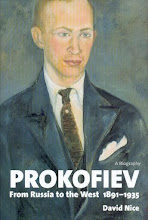
Only one of the dozen I notched up on my noon-to-dawn trawl through Rome features in Respighi's Fontane di Roma, and I was sorry not to pay a fleeting return tribute to the Trevi (nor, for that matter, to the Piazza Navona nor my favourite, the exquisite little turtle fountain in the Jewish quarter, the cleaning of which my fellow-blogger Willym expounded upon so eloquently while he was living there). Bernini's Triton of 1642 rather disappointed me when I first made its acquaintance quite some time after hearing the tone-poem - lonesome in a rather lugubrious sloping square, and ungraced by the tumbling cascades of nymphs Respighi's music suggests (let's have Toscanini in that number before we eventually put together all four musical pictures in two performances by the orchestra I went to hear).
Yet shortly after dawn, in a more or less unpeopled space with less traffic roaring around it than usual, our marine conch-blower did look rather impressive. This time, though, I fell for the more intimate water-tricklers. Robert Hughes, in the latest Roman popular history which I've just starting ploughing into, reminds us that there was no natural water pressure in the ancient city to provide cascades, just modest tumbles via the several aqueducts that sloped, and in some uneven places were persuaded by tunnels to slope, into the centre. Two re-used mascheroni first, then, one on the wall that separates Santa Sabina from the Parco Savello on the Aventine, designed by Giacomo della Porta in 1583

and the other, which you must forgive me for repeating from the first walking-tour piece, at the prettiest end of the Via Giulia

commissioned by the Farnese family living in the famous palace which now backs on to the street, and which of course has a rather splendid fountain of its own in the square on the other side.

I'll save up the modest effort in front of Sant'Andrea della Valle for a Tosca ramble and jump to early next morning, when I passed Bernini's Barcaccia being cleaned in the rosy dawn (but it rarely photographs well)

and climbed the hill past the Triton to the four commissioned by the 'manic-impressive' (thank you, Robert Hughes, who paints a terrifying picture of him) Sixtus V between 1588 and 1593, giving their name to Borromini's San Carlo alle Quattro Fontane. Three are by that Pope's great planner Domenico Fontana (would you believe): Juno

the Arno

and the Tiber

while the fourth, Pietro da Cortona's Diana, is seen from a distance in context.

Fontana as master of Sixtus V's most grandiose projects was also responsible for the Fontana dell'Acqua Felice with Moses in the middle, terminus of the clean-water viaduct of that name. This has had the clean-up the four down the road still need, and attempts to work on Santa Maria della Vittoria with the famously agonial-ecstatic Bernini St Teresa within are graced by a contrasting piece of advertising.

Well, that was it before I reached a different sort of terminus in time for the 7.52 train to the airport. But, as I wade my pleasurable way through eight CDs of mostly treasurable archival material from the Accademia Nazionale di Santa Cecilia, let's see as well as hear the orchestra on happy home-territory form in Respighi's Fontane as equally divided between Pappano for the first two
and the ever-underrated Pretre (I'm sure it is) for a very vivacious Trevi at noon and the Villa Medici at sunset.





